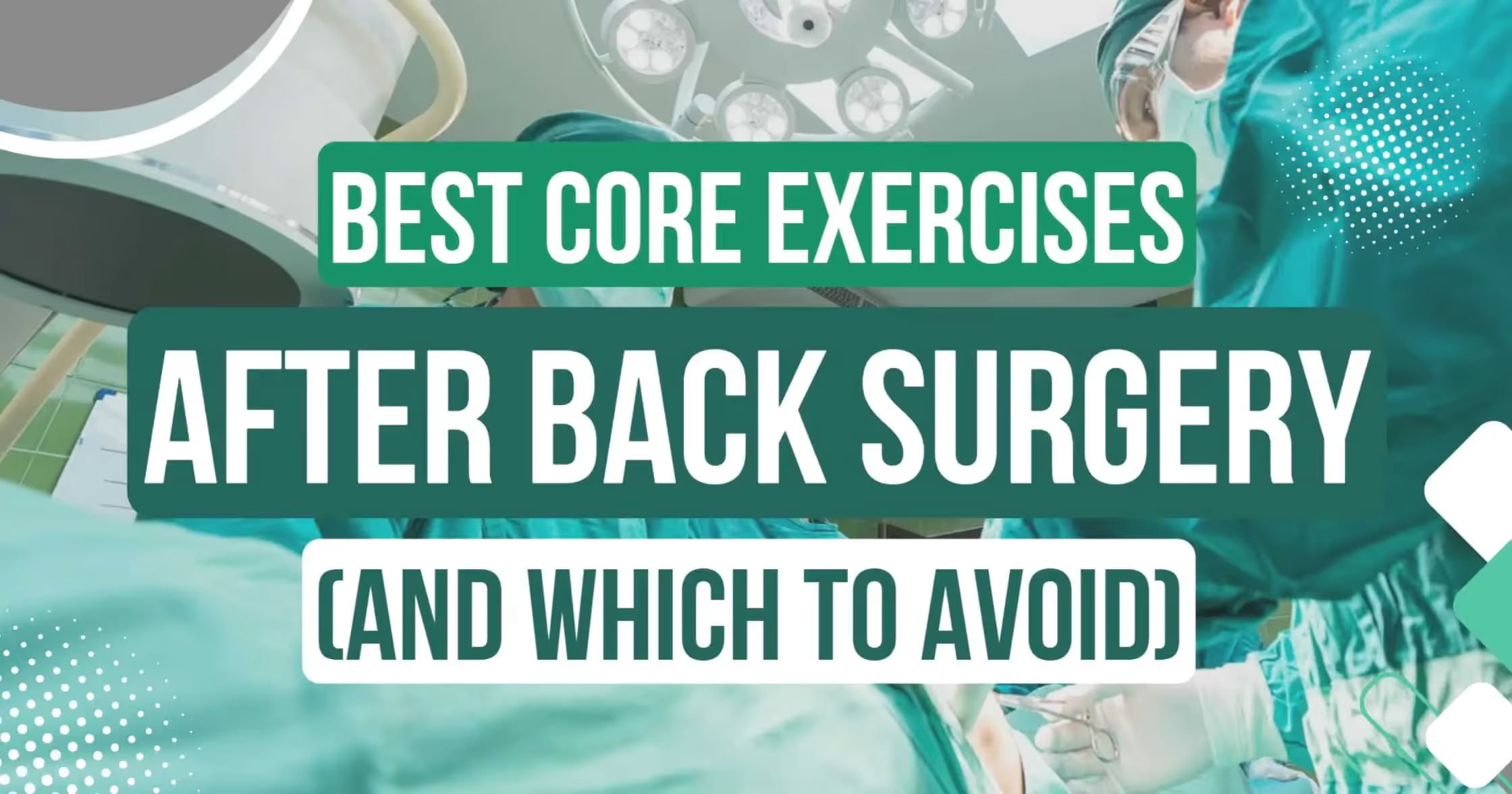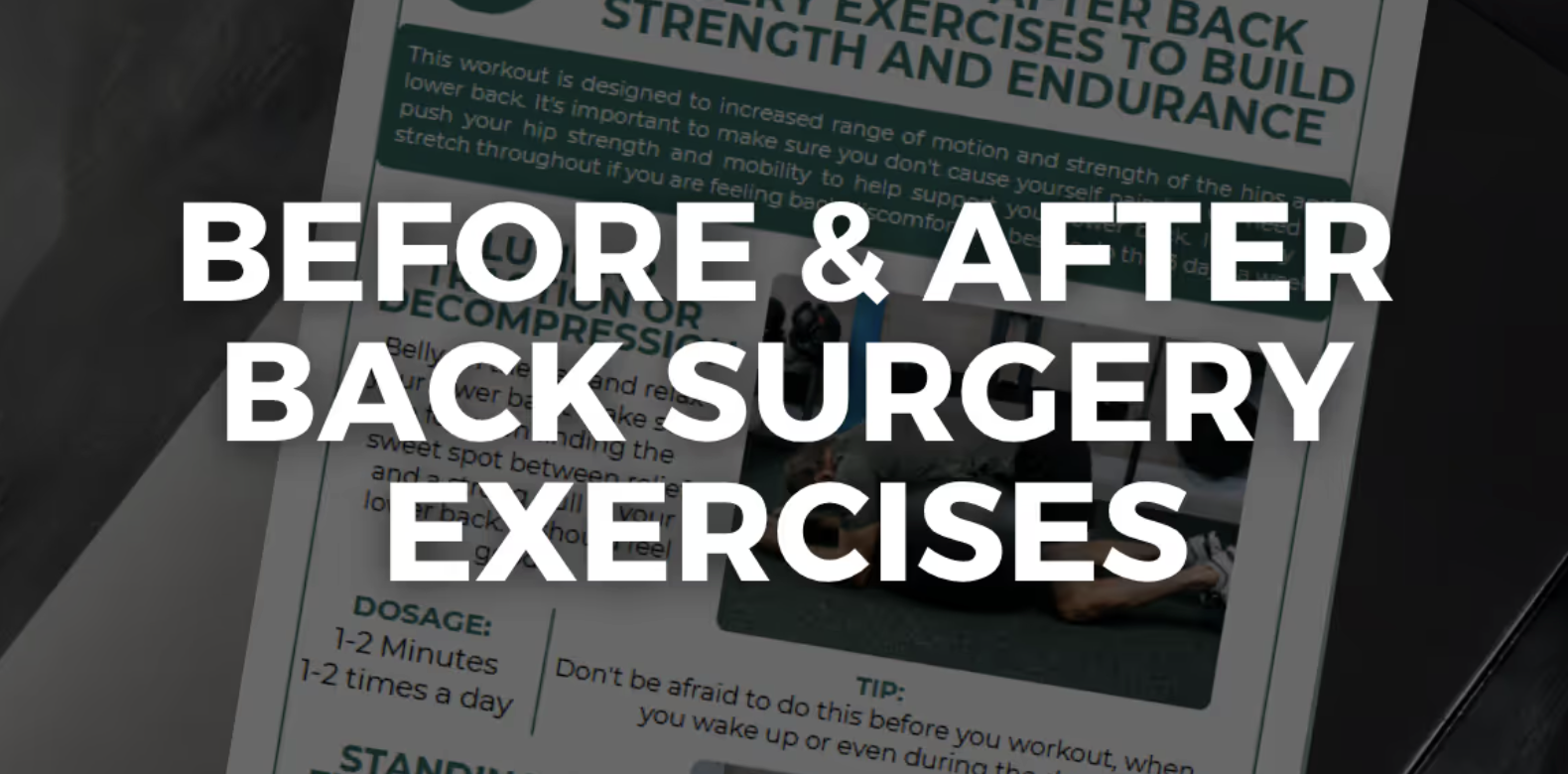
Best Core Exercises After Back Surgery (And Which to Avoid)
The best core exercises after back surgery are those that improve tissue tolerance and positional awareness without aggravating your symptoms. For most patients, this includes gentle movements like bird dogs, and modified planks. In my 10+ years of PT experience, I’ve found that the key to a successful recovery is focusing on the lumbopelvic complex rather than just the back.
Your "Core" is More Than Just Six-Pack Abs
When I work with private patients in Jacksonville, I often hear, "I need to strengthen my core so my back doesn't go out again." But here is the secret: your core isn't just your stomach muscles. I like to refer to the hips and lower back as the lumbopelvic complex.
Think of your spine like a hallway and the nerves as the doorways. Surgery is often done to clear the "clutter" out of those doorways so the nerves can breathe. To keep that hallway clear, we need the muscles of the hips, glutes, and back to work together to support the structure.
Remember, just because your MRI shows some "wear and tear" doesn't mean you're broken. We all have wrinkles on the inside as we age; the goal of rehab is to make sure those wrinkles don't stop you from living your life.
Exercises to Avoid After Back Surgery (The "Red Light" List)
Immediately following surgery, your surgeon likely gave you the "BLT" rule: No Bending, Lifting, or Twisting. This applies to your exercise routine as well.
- Weighted Squats or Deadlifts: While unweighted squats are often fine, adding heavy external loads too early can exceed your current tissue tolerance.
- Traditional Sit-ups or Crunches: These force the spine into significant flexion (bending), which can put undue stress on a healing discectomy or fusion site.
- High-Impact Cardio: Running or jumping should be avoided until your bone has solidified (in the case of a fusion) or your soft tissue has healed.
- Aggressive End-Range Stretching: Pushing through sharp pain to "loosen up" can actually trigger more inflammation.
I created this PDF that gives you exercises to do before and after back surgery.

5 Expert-Approved Core Exercises for Recovery After Back Surgery
We want to choose exercises that meet the "Green Light" criteria: high muscle activation with low spinal stress.
1. Pelvic Tilts (Positional Awareness)
This is the foundation of recovery. It helps your brain "find" your spine again after the trauma of surgery. - no joke, this is real.
- How to do it: Lie on your back with knees bent. Gently flatten your back against the floor by tightening your stomach.
- Hold: 2-3 seconds, repeat 10-15 times.

2. The Bird Dog (Core and Lower Back)
This exercise shows high activity in your trunk stabilizers.
- How to do it: On hands and knees, extend the opposite arm and leg simultaneously while keeping your back as still as a table.
- Expert Tip: Don't lift your leg high; reach it long to maintain a neutral spine

3. Bridges (Glute Activation)
Your glutes are part of your core. If they are weak, your lower back has to do double the work.
- How to do it: Lift your hips toward the ceiling, squeezing your glutes at the top.
- Repetitions: 2-3 sets of 10-15 reps.

4. Modified Planks
Planks are great because they emphasize a neutral spine.
- How to do it: Instead of the floor, place your elbows on an elevated surface like a kitchen counter or a sturdy couch.
- Duration: Start with 10-30 seconds.
- Learn more about how to progress to full planks.

5. Nerve Glides (The SPARK Program)
Most people forget to "exercise their nerves". If you had sciatica before surgery, this is a must.
- Why: They cut around the nerves you must nourish them. You do the by sliding and gliding them.
- How to do it: Lie on your back, strap around the ball of your foot. Use your ams to lift your leg as you keep it very straight. Once you feel tension in your calf or leg that is where you stop. Lower your light slightly then lift again. Don't push it but nudge it.
- 10–20 repetitions
- See my full guide on nerve flossing for sciatica in my book!


Best Cardio After Back Surgery
The good news is that it is generally safe and recommended to begin cardiovascular exercise as tolerated sooner rather than later. The following are recommendations for cardiovascular exercise:
- Walking: Gentle on the back and easy to control intensity. Start with whatever distances and durations are tolerable without significantly aggravating symptoms, whether that is 1 minute or 30 minutes. (Uncover the Benefits of Walking and Core Strength)
- Stationary Biking: Non weight bearing but not my favorite.
- Aquatic exercise: Aquatic exercise can be very beneficial for those who may be experiencing higher levels of pain or mobility impairment following surgery, as well as for those with other health considerations, such as weight status, that may make land-based exercise more challenging in the earlier stages of rehab.
.jpeg)
I even created a full walking ebook, that you can check out here. It's a simple core strengthening and mobility plan to help you walk farther and longer without pain.
The Most Common Mistake I See
In my Jacksonville practice, the most common mistake is consistency vs. intensity. Patients often try to do a 1-hour "workout" once a week and end up flared up. You will find much more success doing 10 minutes of gentle movement every single day.
When to Seek Professional Help
You want to reach out to your surgeon if you have
- Loss of bowel or bladder function
- Unrelenting pain that doesn’t change
- You fall
- Severe loss of strength in your legs that is beyond normal for you
Take Your Recovery Further
If you are ready to move beyond basic stretches and want a structured plan:
- Free Resource: Take my Sciatica Quiz to see if your remaining symptoms are disc or bone-related.
- Step-by-Step Training: Download my Before and After Back Surgery Exercise Guide and my Upper Body Strengthening After Back Surgery PDF to ensure you are building strength safely.
- Step-by-Step Plan: Download my Revision Sciatica Book for a full 8-week progression designed to improve your tissue tolerance.
Summary
The best core exercises after back surgery build tissue tolerance and positional awareness without stressing a healing spine, with a focus on the entire lumbopelvic complex rather than just the abs. It highlights safe, low-stress exercises to support recovery while clearly outlining movements to avoid during the early stages of healing. The key message is that consistent, gentle daily movement leads to better long-term results than infrequent, high-intensity workouts.
The best core exercises after back surgery are those that improve tissue tolerance and positional awareness without aggravating your symptoms. For most patients, this includes gentle movements like bird dogs, and modified planks. In my 10+ years of PT experience, I’ve found that the key to a successful recovery is focusing on the lumbopelvic complex rather than just the back.
Your "Core" is More Than Just Six-Pack Abs
When I work with private patients in Jacksonville, I often hear, "I need to strengthen my core so my back doesn't go out again." But here is the secret: your core isn't just your stomach muscles. I like to refer to the hips and lower back as the lumbopelvic complex.
Think of your spine like a hallway and the nerves as the doorways. Surgery is often done to clear the "clutter" out of those doorways so the nerves can breathe. To keep that hallway clear, we need the muscles of the hips, glutes, and back to work together to support the structure.
Remember, just because your MRI shows some "wear and tear" doesn't mean you're broken. We all have wrinkles on the inside as we age; the goal of rehab is to make sure those wrinkles don't stop you from living your life.
Exercises to Avoid After Back Surgery (The "Red Light" List)
Immediately following surgery, your surgeon likely gave you the "BLT" rule: No Bending, Lifting, or Twisting. This applies to your exercise routine as well.
- Weighted Squats or Deadlifts: While unweighted squats are often fine, adding heavy external loads too early can exceed your current tissue tolerance.
- Traditional Sit-ups or Crunches: These force the spine into significant flexion (bending), which can put undue stress on a healing discectomy or fusion site.
- High-Impact Cardio: Running or jumping should be avoided until your bone has solidified (in the case of a fusion) or your soft tissue has healed.
- Aggressive End-Range Stretching: Pushing through sharp pain to "loosen up" can actually trigger more inflammation.
I created this PDF that gives you exercises to do before and after back surgery.

5 Expert-Approved Core Exercises for Recovery After Back Surgery
We want to choose exercises that meet the "Green Light" criteria: high muscle activation with low spinal stress.
1. Pelvic Tilts (Positional Awareness)
This is the foundation of recovery. It helps your brain "find" your spine again after the trauma of surgery. - no joke, this is real.
- How to do it: Lie on your back with knees bent. Gently flatten your back against the floor by tightening your stomach.
- Hold: 2-3 seconds, repeat 10-15 times.

2. The Bird Dog (Core and Lower Back)
This exercise shows high activity in your trunk stabilizers.
- How to do it: On hands and knees, extend the opposite arm and leg simultaneously while keeping your back as still as a table.
- Expert Tip: Don't lift your leg high; reach it long to maintain a neutral spine

3. Bridges (Glute Activation)
Your glutes are part of your core. If they are weak, your lower back has to do double the work.
- How to do it: Lift your hips toward the ceiling, squeezing your glutes at the top.
- Repetitions: 2-3 sets of 10-15 reps.

4. Modified Planks
Planks are great because they emphasize a neutral spine.
- How to do it: Instead of the floor, place your elbows on an elevated surface like a kitchen counter or a sturdy couch.
- Duration: Start with 10-30 seconds.
- Learn more about how to progress to full planks.

5. Nerve Glides (The SPARK Program)
Most people forget to "exercise their nerves". If you had sciatica before surgery, this is a must.
- Why: They cut around the nerves you must nourish them. You do the by sliding and gliding them.
- How to do it: Lie on your back, strap around the ball of your foot. Use your ams to lift your leg as you keep it very straight. Once you feel tension in your calf or leg that is where you stop. Lower your light slightly then lift again. Don't push it but nudge it.
- 10–20 repetitions
- See my full guide on nerve flossing for sciatica in my book!


Best Cardio After Back Surgery
The good news is that it is generally safe and recommended to begin cardiovascular exercise as tolerated sooner rather than later. The following are recommendations for cardiovascular exercise:
- Walking: Gentle on the back and easy to control intensity. Start with whatever distances and durations are tolerable without significantly aggravating symptoms, whether that is 1 minute or 30 minutes. (Uncover the Benefits of Walking and Core Strength)
- Stationary Biking: Non weight bearing but not my favorite.
- Aquatic exercise: Aquatic exercise can be very beneficial for those who may be experiencing higher levels of pain or mobility impairment following surgery, as well as for those with other health considerations, such as weight status, that may make land-based exercise more challenging in the earlier stages of rehab.
.jpeg)
I even created a full walking ebook, that you can check out here. It's a simple core strengthening and mobility plan to help you walk farther and longer without pain.
The Most Common Mistake I See
In my Jacksonville practice, the most common mistake is consistency vs. intensity. Patients often try to do a 1-hour "workout" once a week and end up flared up. You will find much more success doing 10 minutes of gentle movement every single day.
When to Seek Professional Help
You want to reach out to your surgeon if you have
- Loss of bowel or bladder function
- Unrelenting pain that doesn’t change
- You fall
- Severe loss of strength in your legs that is beyond normal for you
Take Your Recovery Further
If you are ready to move beyond basic stretches and want a structured plan:
- Free Resource: Take my Sciatica Quiz to see if your remaining symptoms are disc or bone-related.
- Step-by-Step Training: Download my Before and After Back Surgery Exercise Guide and my Upper Body Strengthening After Back Surgery PDF to ensure you are building strength safely.
- Step-by-Step Plan: Download my Revision Sciatica Book for a full 8-week progression designed to improve your tissue tolerance.
Summary
The best core exercises after back surgery build tissue tolerance and positional awareness without stressing a healing spine, with a focus on the entire lumbopelvic complex rather than just the abs. It highlights safe, low-stress exercises to support recovery while clearly outlining movements to avoid during the early stages of healing. The key message is that consistent, gentle daily movement leads to better long-term results than infrequent, high-intensity workouts.
1. Madera, M., Brady, J., Deily, S., McGinty, T., Moroz, L., Singh, D., Tipton, G., Truumees, E., & for the Seton Spine Rehabilitation Study Group (2017). The role of physical therapy and rehabilitation after lumbar fusion surgery for degenerative disease: a systematic review. Journal of neurosurgery. Spine, 26(6), 694–704. https://doi.org/10.3171/2016.10.SPINE16627




%20Blog%20thumbnails%204.avif)
